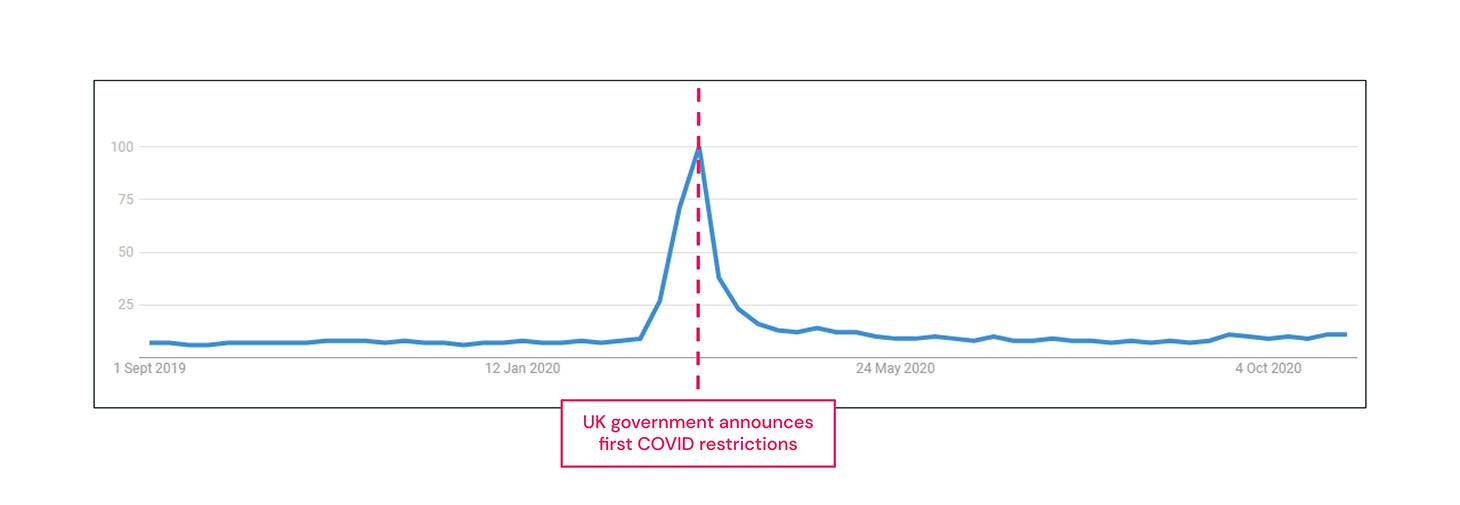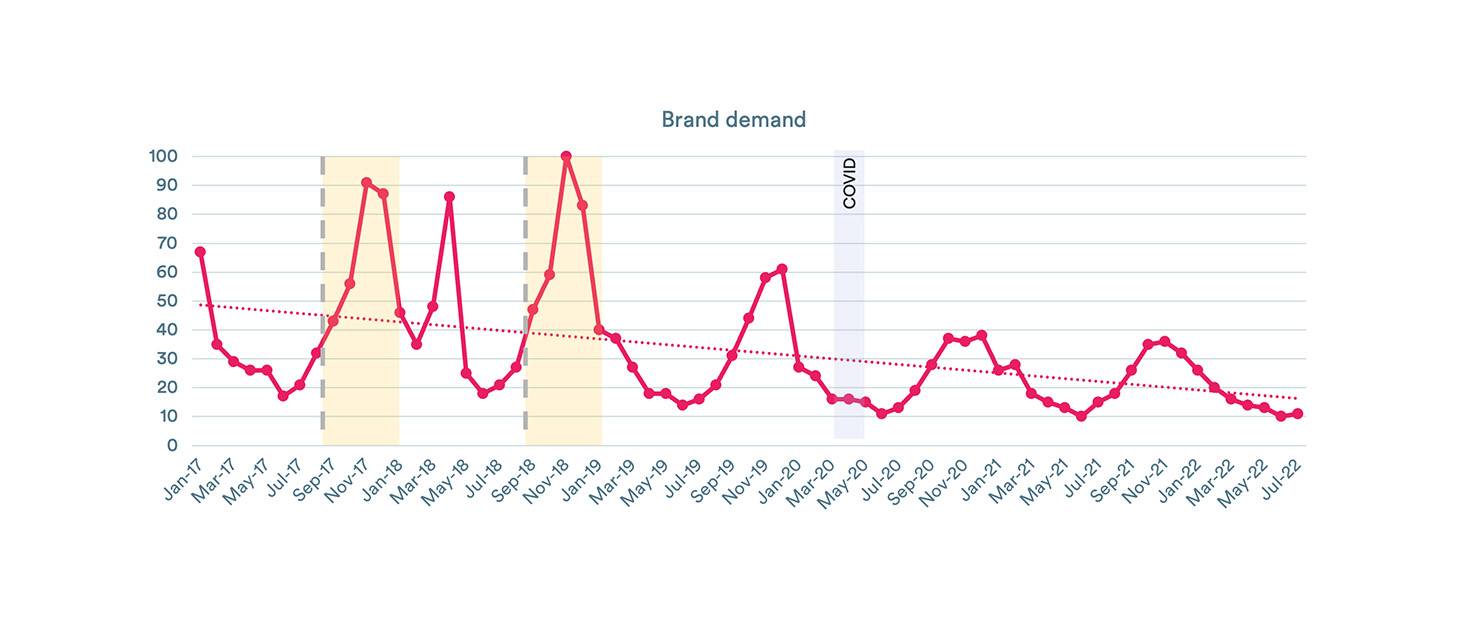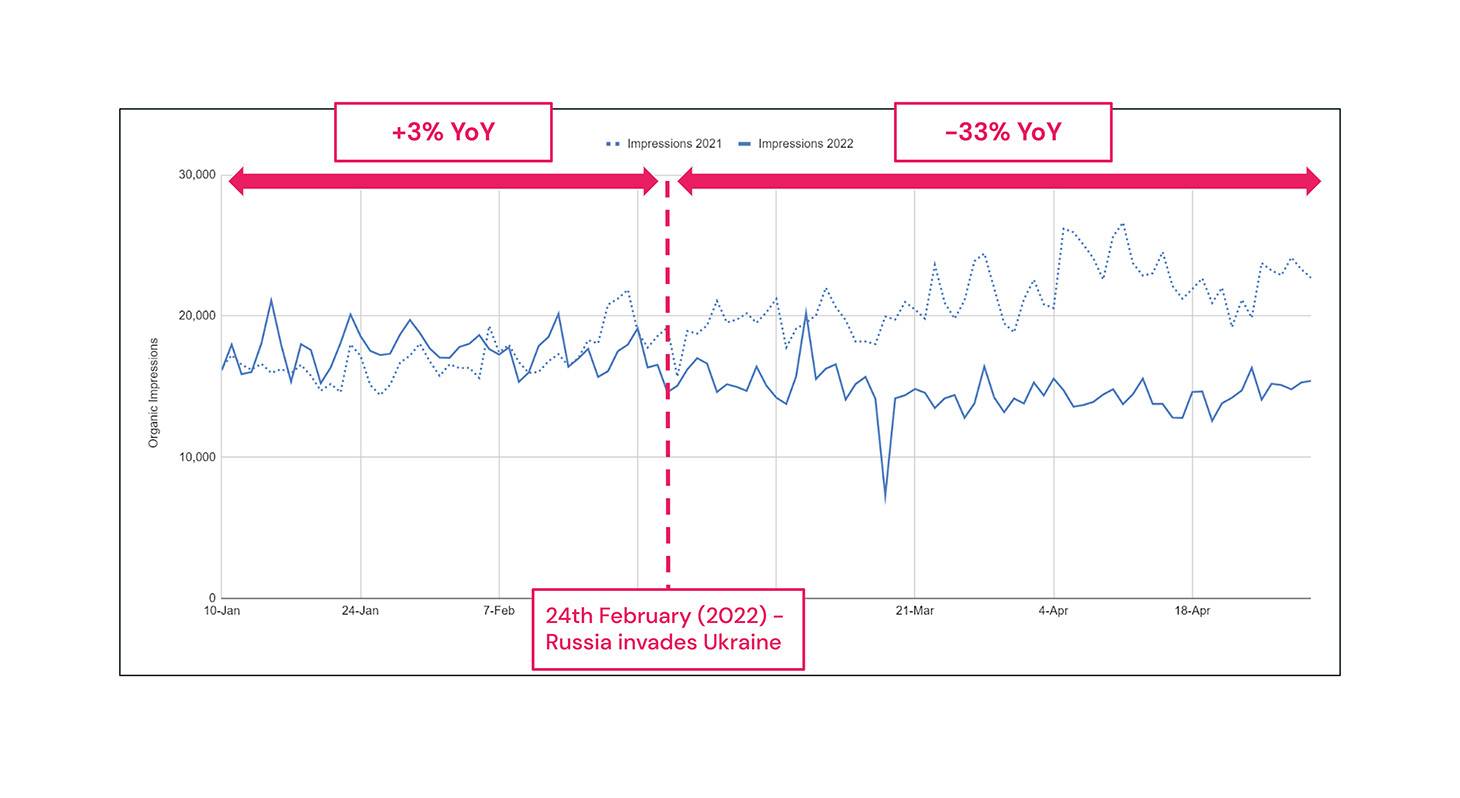The challenge
There’s no denying it: consumer demand is heavily influenced by a multitude of factors that are entirely outside of our control as digital marketers.
At no point has this been clearer than during the COVID pandemic. The graph below shows just how wildly demand fluctuated for toilet roll as people stockpiled everyday items in a panicked response to the first COVID restrictions:

Above: UK demand for ‘toilet roll’ reached an all-time high as people started to stockpile in response to the first COVID restrictions being announced on 16th March 2020
This was good news if you were a supermarket, but what about everyone else? The hospitality industry, for example, really suffered during this period, with each subsequent lockdown causing a severe loss in demand for this sector. In the UK, the only saving grace was the government’s 2020 ‘Eat Out to Help Out’ scheme, which caused an all-time high in demand for restaurants between lockdown one and two:

Above: UK demand for ‘restaurants’ suffered with each of the three national lockdowns (pink lines). The peak between lockdown one and two (in green) was driven by the UK government’s ‘Eat Out to Help Out’ scheme
Yet naturally-occurring disasters aren’t confined to pandemics. What about the weather? One of our global e-commerce clients is no stranger to the impact of extreme weather conditions. As a provider of outdoor apparel in the US, they’ve seen brand demand increase by 50% compared to any other peak period as a result of severe hurricanes. This 50% increase equated to an additional 223,000 monthly searches for their brand.
The increased demand is prolonged if the after-effects of the hurricane are particularly severe, as demonstrated below:

Above: increased demand for one of our e-commerce clients based in the US was observed following particularly aggressive hurricane seasons in 2017 and 2018. Grey dotted lines indicate the first major hurricane of each season (category 4 or above)
We’ve also seen the big impact of geopolitical conflicts on consumer behaviour. Take the Ukrainian war, for example. For one of our motoring clients, brand demand began to decrease almost immediately following the start of the war. This was thanks to the hike in fuel prices that resulted from the invasion. In the months that followed, this translated into 33% less brand demand compared to the previous year:

Above: a client in the motoring industry sees brand impressions decrease by a third YoY following the invasion of Ukraine. Previous to the invasion they were trending up by +3% YoY
No product is immune to the ever-changing climate we find ourselves in, whether it’s a cheap everyday item such as toilet paper, or a big ticket purchase such as a car. In response to increasing inflation and talk of an upcoming recession, we can only expect more change to come our way.
So the big question is, what can digital marketers do to be prepared during uncertain times?
The solution
At Builtvisible, ‘controlling the controllables’ is a strong part of our company ethos. It’s a term in sports psychology that refers to how high-performance teams put 100% of their energy into the things they can control. Being distracted by things that cannot be changed is a waste of precious resources and ultimately leads to overwhelm, confusion and loss of revenue.
This means that, as marketers, to maximise our impact in these challenging times we need to make sure we’re putting all of our energy and effort where it counts. Below we outline key areas where we can have a tangible impact on SEO performance.
1. Be crystal clear on performance
Knowing exactly how you’re performing is key to making the right decisions. This is why this item is number one on the list! Reporting on the right metrics, benchmarking against competitors and segmenting your data are three things that you can do right now to take your reporting to new heights. We discuss each in more detail below.
Report on the right metrics
A common mistake that we come across too often is brands only reporting on traffic and conversions.
This is an issue because these two figures are heavily influenced by a host of factors outside of SEO performance, such as the real-world changes we’ve seen above that heavily impact consumer demand.
For example, your site might be ranking better than ever thanks to the recent implementation of a stellar SEO strategy. Yet because fewer people are searching for your products, traffic is down. It can be easy to blame this on poor SEO performance if you haven’t got other metrics to hand to provide the full context.
Changes to rank are the best true indicator of SEO performance, so it’s imperative to include this in your reports. This is because ranking performance is ultimately where we have the most tangible impact in SEO. Regardless of whether demand is up or down, or PPC spend has increased or decreased, a site’s organic ranking will get better or worse according to how well it’s optimised from an SEO point of view.
Another very important metric is visibility. This metric is similar to rank, yet it’s more sophisticated as it also takes the search volume of keywords into account. For example, a keyword that has 50,000 searches a month and improves from position 5 to 3 might have a huge impact on your site’s visibility. Yet the same ranking improvement on a keyword that has far fewer searches won’t be nearly as effective.
Most third-party tools report on visibility, so this can be easily incorporated into your reporting if you’re not focusing on it already. Just be aware that it’s best to report on visibility across an established group of keywords that are highly relevant to your business. This is because some tools include all and any keywords a site is ranking for in their visibility calculation, which significantly dilutes the relevancy of the data.
Benchmark against competitors
Comparing your performance to competitors is a fantastic way to get clarity on how your business is actually doing. For example, organic traffic may be down due to decreased demand, but this could conceal the fact you’ve overtaken competitors thanks to some strong ranking improvements.
While looking at performance in the context of your competitive landscape enables you to gain clarity on where your brand is at and how you can improve, this isn’t the only benefit. We’ve noticed that nothing gets the attention of key stakeholders like the mention of competitors! Oftentimes it’s the catalyst to finally getting those resources assigned that you’ve been requesting for so long, or the key piece of supporting evidence that finally gets your increased marketing budget approved.
Segment your data by what matters to you
Here at Builtvisible, we always recommend splitting your data into brand and non-brand traffic. However, this is just the start. By further segmenting performance, you gain deeper insight into what’s really going on. This level of granularity allows you to pivot quickly, as you’re able to identify performance issues as well as opportunity areas as soon as they begin to arise. This reactivity ensures that you’re consistently using your SEO resources in the most efficient and effective way possible, resulting in more revenue at a lower cost to the business.
Segmenting performance data according to business priorities will also help you communicate with key stakeholders in a way that matters to them. If you can tie performance back to key business KPIs, you’ll be aligned with the rest of the business and able to work as a team to move things forward.
For example, one of our clients asked us to segment their data according to keyword intent. This is a really valuable way to analyse data because not all keywords have the same commercial value. Keywords with a clear intent to buy (such as ‘audi for sale’) drive more sales than keywords with ambiguous intent (such as ‘audi’). Therefore transactional intent keywords need to be a priority if increased revenue is one of your KPIs. Understanding the intent of keywords is so critical, in fact, that Builtvisible has built a tool that identifies user intent at scale.
Segmenting performance by keyword intent doesn’t just allow us to focus on the most impactful areas for our client, but it also means that we’re able to see whether their customer base is predominantly looking to buy or if they’re just browsing. This is key information that we can feed into our content strategy.
2. Get smart with your budget
Identify where you can get the most out of your spend
A recent article in the Harvard Business Review concluded that “in uncertain times, the best strategy is adaptability.”
Flexibility is key when running digital marketing campaigns. For example, you may find in times of high demand that investing more in PPC allows you to hit strong conversion targets, or perhaps when the market is weak and less users are looking to buy it could be a good time to invest in more brand awareness activity, such as digital PR or top-of-funnel content.
Here at Builtvisible we understand that when organic and paid search work together instead of independently, performance efficiencies can be unlocked, thus providing a greater return on marketing spend. One of the ways we help clients achieve this is by conducting a PPC and SEO cost analysis project. This is where we analyse keyword performance across both channels in order to identify where cross-channel efficiencies can be made.
For example, for a food takeaway client we found that in three months they had spent £78,000 bidding on keywords where they already ranked in position one in the organic search results. This spend could have been more effective in areas where the client didn’t occupy position one of organic search, or could have even been moved to another digital channel altogether.
Continue to invest in SEO
While it’s important to remain flexible and to have the ability to adjust budgets between teams, now is not the time to be cutting costs in your SEO department. This is because of several reasons:
1. SEO is an ‘always on’ activity
SEO is not like paid advertising; you can’t turn it on and off as and when it suits. In the organic channel, it takes time to gain momentum and to see the results of your hard work. It therefore requires a long-term commitment to really reap the rewards.
2. Just because you stop investing doesn’t mean your competitors will
More companies than ever now invest in SEO. This is in no small part thanks to the recent pandemic which highlighted the importance of businesses having an online presence in order to survive.
With this in mind, a lot of the SEO work that you’re doing will simply be protecting your current performance. If you stop investing in SEO while competitors continue to do so, you’re at a big risk of falling behind.
We’re an SEO agency, so don’t just take our word for it. The Institute of Practitioners in Advertising (IPA) have been running a series of adverts to remind companies of the value of continuing to market themselves in times of economic instability (see below). In their report ‘Advertising in a Downturn’ they conclude that “cutting budgets will only be profitable in the short-term and ultimately the brand will emerge much weaker”. The very same can be said of your SEO efforts.

Above: the IPA have been running a series of advertisements to remind companies of the value of continuing to invest in brand even in a downturn
3. Keep a close eye on consumer trends and react accordingly
During challenging economic times, demand for products and services don’t simply decline, they also shift. As marketers, it’s our job to identify these shifts and to respond accordingly.
Sometimes these shifts are pleasantly surprising. Following the pandemic, for example, travellers were willing to spend more on their holidays. In Google’s presentation “The Expectations of the Evolving Traveller 2022”, they identified that over a third of travellers were likely to spend significantly more than usual on their next leisure trip, while 38% said that they were more likely than ever before to plan or book a ‘once in a lifetime’ holiday.
Anyone operating in the travel industry, particularly at the luxury end of the scale, would be wise to invest more heavily in bottom-of-funnel activities (such as increasing PPC spend) in order to capitalise on this increased demand.
4. Create positive associations with your brand
Even the worst economic downturns don’t last forever, and when consumer spending returns to more buoyant levels, you want to make sure that your brand is the one consumers turn to when they’re ready to start buying again.
Providing a good user experience is a great way to create positive brand sentiment and is something that is fully within your control. It also improves conversion rates, which means that you can generate the same amount of revenue from fewer visitors. This matters more than ever when there are fewer opportunities to convert users thanks to sluggish demand.
Abbey Grocott, Builtvisible’s resident UX specialist, emphasises the importance of focusing in this area: “Our work should always be viewed through the lens of user experience. Google’s priority is to put users in front of content that most accurately matches the intent behind their search. They’re constantly developing their algorithm to ensure the content which most considers the users’ wants, needs and behaviours (the user experience) will rank first.”
Improving user experience can be achieved in many ways and is beyond the scope of this blog post. Instead, we’ll focus on just two key areas that can provide quick wins and are relatively simple to implement.
Help users find what they need
Clear internal linking is not only beneficial from a technical SEO perspective but also helps users to more easily find what they need.
When you know which pages are most in demand on your site, you can update your main navigation to link out to these important areas. This should help to give these pages a ranking boost but will also help users to find this content more easily.
For example, we recently provided internal linking recommendations to one of our clients in order to help them increase the visibility of their finance calculator tool. Given the increasing cost of living, users are more concerned with the affordability of items and if they can manage their repayments. We’ve responded accordingly by making it easier for them to find this useful tool. As this finance tool generates commission for the client, this is a win-win for both the brand and the customer.
Anticipate your users’ needs
A good website fulfils a customer’s intent. It’s important therefore to make sure that you provide all the necessary information that users were seeking when they carried out their search that brought them to your site. This is not only key from a user perspective, but it’s also an increasingly important factor for performing well in organic search, as highlighted by Google’s recent Helpful Content Updates.
This can be achieved with strong on-page copy that’s informed by your sales teams and help centre representatives. Find out what customers are frequently reaching out to ask, and make sure intent is effectively answered in your web pages.
For example, while uncertain times call for more clarity and reassurance from customers, other external factors can have an impact as well. During the heatwave in July 2022, one of our clients had unprecedented demand for their outdoor swimming activities. Their helplines became overwhelmed with customers calling up and asking questions, which could have been avoided with more customer-centric on-page copy.
5. Continue to develop brand awareness
Economic downturns and political instability don’t last forever. On top of this, even if people aren’t actively buying, they’re definitely still searching.
This is why it’s so important to continue investing in brand-promoting activities. It ensures that you’re top of mind not only during periods of uncertainty, but also when conditions pick back up and users are back in the market to buy again.
You can develop a content and digital PR strategy that focuses on producing and promoting high quality top-of-funnel content that genuinely helps users, by contributing to current conversations and answering any questions and concerns that users may have.
For example, our client GLL set up warm spaces in some of their centres in response to the increasing costs of heating and the anticipation of a difficult winter for many. While this was not a revenue-driving activity, the digital PR team at Builtvisible managed to secure strong coverage through outreach activities. The result was acquisition of a number of backlinks to their site with an average domain authority score of 59 and trust flow score of 35.
Not only was this beneficial from an SEO standpoint, as the backlinks strengthened their domain authority, but it also increased awareness of the brand in a very positive way and has helped those looking for warm spaces to find these centres.
Need help with your organic strategy through these uncertain times?
This is no doubt a challenging time for many businesses, and here at Builtvisible we’re a trusted partner to help our clients navigate difficult circumstances with ease.
With dedicated specialist teams across technical SEO, content, digital PR and analytics, we can effectively help you achieve your marketing goals, no matter what those are.
As we’ve just seen, there are many ways that we can help you to maximise your ROI during this challenging period. If you feel you might need some help with this, feel free to get in touch.
